Leave a Comment:
(3) comments
Thankyou very much, for the information and insight. I would like to obtain more information if possible? Thanks, again
Reply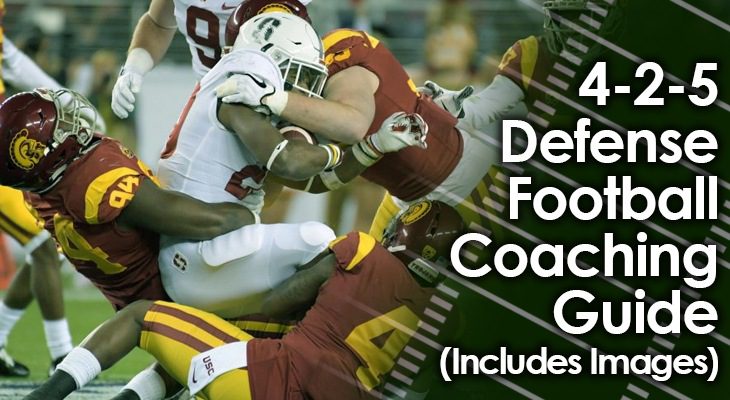
More than 10 years ago, the 4-2-5 defensive alignment was created as a wrinkle in defensive formations that caused opposing offenses a lot of headaches.
It’s an alignment that attacks, attacks, and attacks some more with almost free will…
Relying on players to use their instincts to make quick decisions instead of reading the full play and reacting.
The defense calls for mostly smaller, athletic players who can cause havoc by running all over the field and by getting at the quarterback, receivers, and ball handlers quickly.
But today’s game of football has evolved on the other side of the ball too, as offenses have studied the 4-2-5 defensive alignment and have made adjustments of their own to counteract it.
Many more teams are running a spread option and are utilizing what’s known as run-pass options (or RPOs) to take advantage of the 4-2-5 formation asking defenders to play with their instincts instead of reading and reacting.
So, is the 4-2-5 defense still a formation that will work in today’s game?
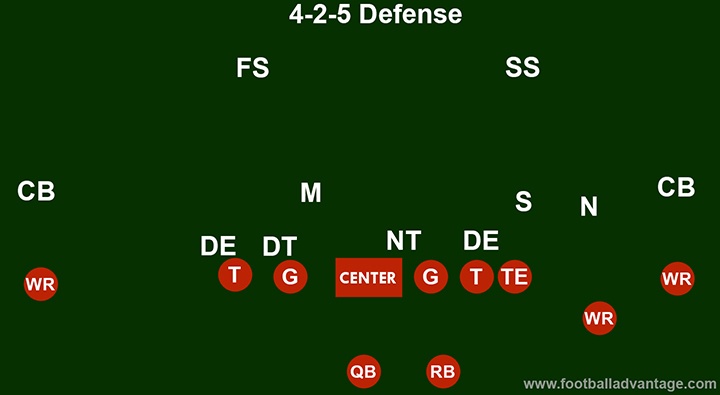
A 4-2-5 formation is great for defenses that are speedy at all three levels (defensive linemen, linebacker and secondary) and that have players with great instincts, a tenacious and aggressive approach, and the strength to match up with bigger receivers.
It’s designed to break away from the typical definitions of each separate position to provide a lot more pressure on offenses up front.
The key to any 4-2-5 defense is whether your team has three components:
1. A strong, big-bodied, traditional nose tackle who can clog up the middle of the offensive line.
2. Defensive ends and linebackers who are smaller in size but quick on their feet to cause problems in blocking.
3. A group of players in the secondary who are rangy, smart and can cover really, really well.
Creates Problems Up Front - A 4-2-5 defense can cause all types of havoc for an opposing offense, with a big nose tackle clogging the middle and hybrid defense ends creating pressure from the outside.
Doesn’t Rely on Play Recognition - Defensive players, especially linebackers, aren’t asked to sit back, read a play at the snap of the ball and then react to it. Instead, they are taught to react at the snap of the ball based on their instincts of what certain offensive formations, alignments, and down-and-distance tell them.
Reduces Coverage Time - Creating more pressure on offenses up front should reduce the amount of time defensive players have to cover receivers running routes. And if that pressure isn’t created, there’s still five players in the secondary to do their job.
Can Be Used in Multiple Formats - A 4-2-5 defense was not designed just to stop the pass. It also is a problem for offensive run games because of the problems it can cause for the offensive line.
Confuses Quarterbacks - The alignment isn’t one that’s widely used in football, so it isn’t as widely studied by offenses in game preparation. While the alignment looks the same up front, the different body types of the players, and maybe even how they line up at the line of scrimmage, could cause a lot of confusion.
Could Have Trouble Adjusting - One downfall to the 4-2-5 defense is it could be susceptible to play-action passes or RPO plays. That’s because linebackers and the secondary are taught to play with their instincts instead of reacting to the play once it develops, which could potentially opening space for receivers across the field.
Could Be a Problem Without Pressure - The idea behind the alignment is to create pressure to reduce time for big plays. But if that pressure isn’t there on a particular play, there could be a lot of time and plenty of space on the field for a big offensive conversion.
Space in the Middle - The trade-off for having four down linemen in this nickel-esque defensive alignment is having only two linebackers. That creates more space in the middle of the field for offenses, and could create a lot of mismatches on tight ends especially.
Could Create Mismatches - Bigger, taller, athletic receivers could have a fun time going against the 4-2-5 alignment. Because the defenders in such a system will usually be on the smaller side. Offenses could be able to take advantage of these possible height mismatches.
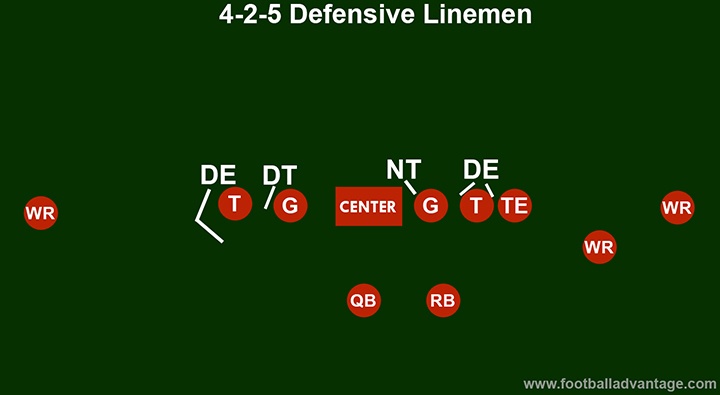
The 4-2-5 defensive alignment starts up front with the big guys.
There are four “down” linemen in this formation, and while it looks like a more traditional base defensive alignment, it throws a few wrenches into that categorization.
For the most part, the make-up and skillset of each of the players on the defensive line in a 4-2-5 defense are vastly different than in a base defense with four down linemen.
With one notable exception:
The nose tackle.
The nose tackle in a 4-2-5 defense could be perhaps the most important position on the field. That’s because the nose tackle might be the only “big body” the defense has on the field.
All the other players could be on the smaller side, exchanging size for speed and athleticism.
The role of the nose tackle is to clog up the middle of the offensive line and take on literally as many blockers as he possibly can. His initial lining up position will be somewhere between the center and the guard.
It’s not necessarily important that the nose tackle put pressure on the quarterback or make any stops in the run game himself at all.
His responsibility is to take on blockers to create holes for linebackers to plug or for them to blitz into. That’s why it’s really important the nose tackle is a very big, strong player who can take a pounding.
The other defensive tackle in the 4-2-5 system will often line up on the outside shoulder of the other offensive guard.
This is because the nose tackle should be handling the center and the other guard by himself.
This other defensive tackle’s job is to create pressure from the down position, getting into either the A or B gap on his side of the center.
It gets interesting at the defensive end positions.
Some of the more successful 4-2-5 defenses have traded traditional-bodied defensive ends for outside linebackers who now serve as ends.
As former outside linebackers, these now hybrid defensive ends have a lot of speed and still a good amount of strength to get to the ball.
Further creating problems for offensive tackles, these hybrid defensive ends will oftentimes line up at the line of scrimmage, but in a two-point stance instead of a three-point stance with their hand on the ground.
This initially causes concern for offensive tackles who know they are about face a speedy challenge and must get off the ball quickly themselves, otherwise the defenders will be past them before they know it.
These hybrid ends also could drop back into coverage on a blitz play where a cornerback or safety is rushing the quarterback.
Having smaller players line up at defensive end could be a problem if they’re not creating pressure on the offense, as they aren’t often equipped to directly take on big, beefy offensive tackles.
That’s why it’s essential that their first step when the ball is snapped is effective and quick, causing the offense to react to them instead of the other way around.
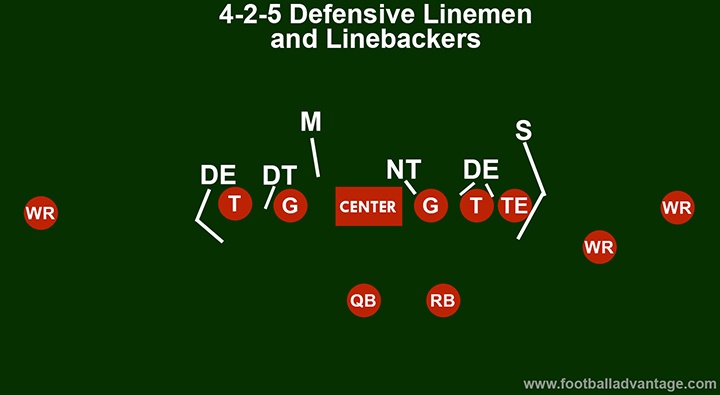
There are only two linebackers in a 4-2-5 defense, and both of these players are on the quicker side as well.
The Mike, or middle linebacker, will line up on the interior of the defense, shading the nose tackle on either one of his shoulders.
The Mike linebacker’s primary duties are to plug up the B-gap in run or blitzing situations. This will be the space that the nose tackle will hopefully free up by taking on two blockers of his own.
Mike linebackers in the 4-2-5 system might fit more of the prototypical characteristics of a strong-side linebacker in other base defenses.
He needs to be quick enough to make adjustments on a run play versus a pass play, especially if he has coverage assignments on a passing play.
The Mike is probably the one player on the field in this alignment that needs to play with a little hesitation, reading an offense quickly first and then picking up his responsibilities based off what he sees, rather than just rushing straight to the line to plug a hole.
The second linebacker in this system will be a strong-side linebacker, or Sam.
The Sam in a 4-2-5 defense can often be converted strong safeties, players who at one time may have been small enough to play safety but have bulked up recently.
Converted safeties are very experienced in coverage, and they also are used to playing near the line of scrimmage and making tackles.
The Sam is one of the most versatile players on the field in a 4-2-5 alignment, as he is tasked with putting pressure on the quarterback, making stops in the run game, and covering receivers as well.
If there are no tight ends on the field, the Sam will still line up on the strong side of the field and have coverage responsibilities for slot receivers if he isn’t blitzing.
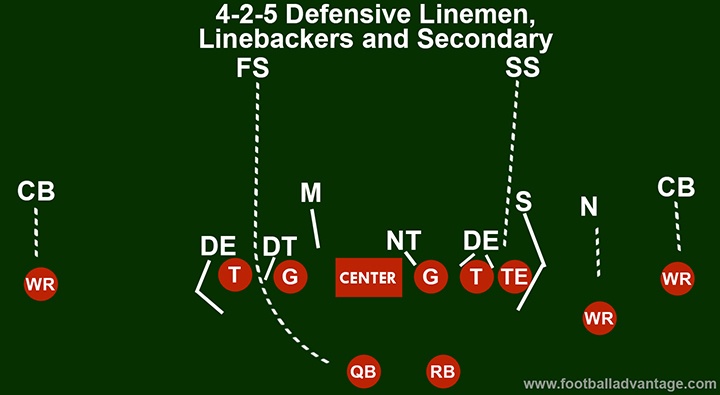
The secondary in a 4-2-5 defense is very similar to that of other nickel defensive formations in that there are two typical cornerbacks, two typical safeties, and then a third nickelback who often has skills of both a safety and cornerback.
The most important attribute in the secondary is speed and coverage ability.
As we mentioned before, the key to a 4-2-5 defense is creating pressure up front, which often reduces the amount of time the secondary is forced into coverage.
This is essential because the longer the secondary in this system is forced to cover straight up, the more possibilities there are for big plays by the offense.
Positioning, alignment, and ability to run are the keys to a successful secondary in a 4-2-5 defensive alignment.
The free safety and strong safety have similar assignments to defenses in other more “base” alignments.
However, they are used to either blitz more often or provide run support near the line of scrimmage, or when a cornerback blitzes, they have to compensate with more coverage responsibilities.
The cornerbacks’ responsibilities are simple – cover and cover well.
Cornerbacks may be asked to cover receivers in more of a one-on-one approach instead of with zone coverage, especially when offenses are lined up in multiple-receiver sets.
This is because there are only two linebackers to help in coverage, and most of the time, one of those linebackers is playing closer to the line of scrimmage.
That one fewer linebacker on the field can also open up extra space in the middle of the field for offenses, which is why it’s essential that the two cornerbacks and the nickelback all have the ability to move quickly, especially laterally.
Offenses usually try to attack a 4-2-5 defense with either running plays or passing plays that don’t take as long to develop to try to counteract the pressure that’s being created up front by the quick defensive ends and linebackers.
That means at the snap of the ball, each member of the secondary must be on top of his game and be able to react quickly to his assignment.
The 4-2-5 defense is a nice option for coaches who have players on the defensive side of the ball who are either undersized or are super athletic and speedy.
This defensive alignment will actually be able to compensate for the lack of size and take advantage of the speed by creating mismatches for the offense at the line of scrimmage.
This will hopefully cancel out the advantages bigger receivers might have over a smaller secondary.
The big exception to this is the nose tackle, who needs to be big, beefy, strong and able to take on multiple offensive linemen every play.
The nose tackle is the key to the entire system, really.
If he is able to clog up the middle of the offensive line, forcing at least both a center and guard to block him on every play, then that will free up room for the linebackers, safeties, and even cornerbacks to put pressure at the line of scrimmage.
Similarly, being able to utilize a hybrid defensive end who may have some experience as an outside linebacker could cause fits for offensive tackles who are used to squaring off against bigger defensive ends.
Hybrid ends who are smaller but quicker and who start in a two-point stance force these bigger, slower offensive tackles to have a very quick first step to protect the backfield.
The 4-2-5 defense is not a great alignment, though, for teams who have bigger, slower defensive players who aren’t versatile.
The lack of speed will catch up to that team quickly as the offense is able to take advantage of the extra space over the middle of the field that the alignment creates.Thankyou very much, for the information and insight. I would like to obtain more information if possible? Thanks, again
Reply